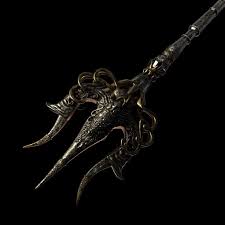Key Point: A Trishula is a traditional Indian weapon and symbol, consisting of a trident or three-pronged spear, often associated with Hindu deities and used in both mythology and martial arts.
In this article on mythical weapons from ancient legends we are taking a look at the Trishula. We will examine, what this weapon was, who wields it, and what special properties it holds in legends, if any …
So, as always it is important we define what Trishula is before we go deeper.
What Exactly Is Trishula?
According to “Hindu Mythology: Vedic and Puranic” by W.J. Wilkins Trishula is described as a trident with three prongs, symbolizing the trinity of creation, preservation, and destruction. It is depicted as a weapon with divine powers in the hands of Lord Shiva. And it is believed to represent his authority over the three gunas—Sattva, Rajas, and Tamas—of the universe.

That was the short introduction to this marvelous legendary weapon. So now, let’s examine this in a little more detail.
Historical And Cultural Background
Trishula is often portrayed as a three-pronged spear or trident made of various materials, including iron or gold.
The central prong is usually longer and represents the power of Lord Shiva, while the other two prongs symbolize His consort, Goddess Parvati, and their union. In the historical context, Trishula finds its roots in ancient Indian culture and mythology.
It was used not only as a weapon but also as a symbol of power and divine authority. The trident’s association with Lord Shiva emphasizes His role as the destroyer of evil forces and the protector of cosmic order.
So, next, let’s explore its mythical properties and powers.
Mythical Properties Of Trishula
According to legends, Trishula is believed to possess immense divine attributes. On a weirder note… it is said to grant Lord Shiva the ability to annihilate ignorance, attachments, and ego, leading to spiritual enlightenment (that power would come in handy in the modern era).
The trident’s sharp prongs also represent the destruction of negative forces and the triumph of righteousness. On a cooler note, Trishula is also associated with the control of cosmic elements, as Lord Shiva’s command over the trident allows Him to manipulate fire, water, and wind.
Which is a useful power to have.
Trishulas’ powers are kind of cooler than the powers of this weapon.
Now, let’s turn our attention to stories where Trishula was prominently used.
Stories Featuring Its Use
So, what are some legends that show the Trishula in action?
In the epic Mahabharata, Lord Shiva gifted Trishula to the mighty warrior Arjuna as a mark of divine favor. Arjuna wielded the trident with exceptional skill and valor during his battles.
Trishula’s presence in these tales highlights its association with strength, courage, and victory. Furthermore, various mythological stories depict Trishula as an instrument used by Lord Shiva to vanquish demons and restore balance in the world.
So, as you can see the weapon plays a huge role in Hindu stories. And the powers that are ascribed to the weapon reflect its importance in the Hindu mythos.
Now, to tie everything together, let’s explore the presence of Trishula in modern media and cultural references.
Trishula In Modern Media
In popular cinema, the trident has been depicted in movies featuring Hindu mythological themes. For example, in the film “Devon Ke Dev…Mahadev,” the character of Lord Shiva is often portrayed wielding Trishula as a symbol of his divine power and authority.
Beyond films, Trishula has also found its way into contemporary literature, graphic novels, and artwork inspired by Hindu mythology. Artists and writers often incorporate Trishula as a visual motif, representing the strength and transcendence associated with Lord Shiva.
Furthermore, Trishula has become a popular symbol in tattoo artistry, where individuals choose to permanently adorn themselves with this iconic three-pronged weapon as a tribute to their reverence for Hindu mythology and Lord Shiva. Which is kind of cool in my opinion.
In Conclusion
Thank you for taking the time to read this article. I hope you learned something new. And if you wish to continue learning I suggest taking a look at the Clarent sword from Arthurian legends, right here.
Take care!
Sources:
“The Illustrated Dictionary of Hindu Iconography” by Margaret Stutley
“Hindu Mythology: Vedic and Puranic” by W.J. Wilkins
Epic Mahabharata